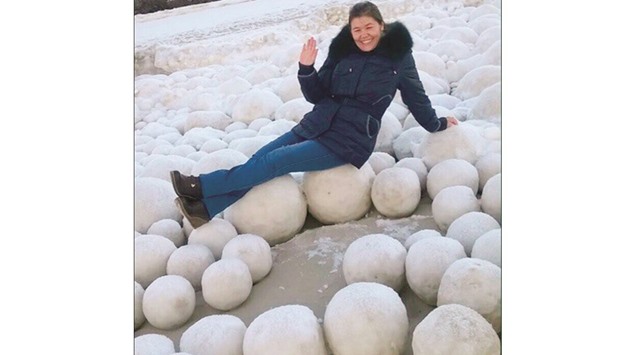Giant snowballs have mysteriously appeared on a beach in northern Russia. At least 18 kilometres of the coastline have been covered by the balls, and the locals say it could be much more than that, but they can’t be sure because the weather is too bad for them to go out and investigate.
The snowballs aren’t part of a giant art installation, they’re completely natural. They come in a variety of sizes. Some are up to 25 centimetres in diameter, the size of a basketball, whereas some are the size of tennis balls. The locals say the balls have been appearing over the last week or so, and they’ve never seen anything like it.
Northern Russia isn’t the first place in the world to see an invasion of giant icy spheres. Similar balls occasionally appear on the edges of the Great Lakes in North America. Those that emerged in Lake Michigan in January 2014 were in the water, rather than on the shore, and this gives a clue as to their origin.
The balls form in water, and to do so, the water has to be very near freezing. Initially chunks of ice will start to form on the surface, but the movement of the waves near the shore breaks the ice into pieces. These pieces of ice will start to grow, but are continuously thrown against the shore. The movement ensures that any sharp edges are knocked off the ice, and their surfaces remain smooth.
If you cut one of the ice blocks in half, you should be able to see a series of concentric rings; layers of ice combined with sand that the spheres have picked up from the shore. This is similar to the growth of a grain of hail. Hailstones are thrown up and down within a thunder cloud, picking up ice as it circles around in the cloud. The more times that the hail circulates, the more rings of ice it picks up and the larger it becomes. Eventually the hailstone becomes too heavy for the cloud to support, and the hail falls to the ground. When it hails in Doha, you can slice through the middle of a hailstone and you should also find concentric layers of ice. This is provided the hailstone is big enough for you to make out the details of course!
Layers of ice were seen in the icy balls which formed in Lake Michigan at the beginning of 2014, as they were in Russia; however, in Russia the balls were on the beach, rather than in the sea. This is because the wind, or simply the tide, had pushed the balls of ice onto the shore. Here they had frozen and been coated with snow. Some of the balls had even been rolled along by the wind, leaving tracks in the snow, showing where they had moved.
If the balls of ice had continued to move along the shore, they could have formed even larger snowballs. In fact, sometimes snow can start to roll naturally, away from the coast. This again is a rare phenomenon, but one that has been spotted in North America and in parts of Europe.
To make snow rolls, there needs to be a keen breeze and the surface of the snow needs to be nearly at melting point. This could be because the weather is getting warmer, or because sunshine has started to shimmer on the snow. If the top of the snow is near melting point, the snow is rather sticky, and the wind can pick up this sticky layer, peeling it off from the powdery snow underneath.
The wind then rolls chunks of the sticky snow along the ground, much like someone making a snowman might push a big ball of snow along. However, the naturally made snow rolls usually end up being cylindrical in shape, rather than spherical, and they are also often hollow in the middle. This is because the central rolls are often weak and not as well packed as the outer layers, so can be easily blown away.
Like the naturally occurring snowballs, the rollers can come in any size, the biggest ones can be up to 60 centimetres across. They eventually come to a halt when the wind eases or when the rolls become too heavy for the wind to move.
Whether it be snow rolls, or giant snowballs, winter can clearly lead to strange and mysterious landscapes. Now that Doha is my home, there are times that I miss the chance of seeing some wintry weather. It would be nice to see a few flurries of snow, or to build a snowman. However, I certainly don’t miss everything that goes with it. I don’t miss the short winter days nor the seemingly-endless months of cold weather. The mild winters that we enjoy in Qatar suit me perfectly.

At least 18 kilometres of a beach in Russia have been covered by the giant snowballs. Photos by Ekaterina Chernykh/Courtesy of Siberian Times


